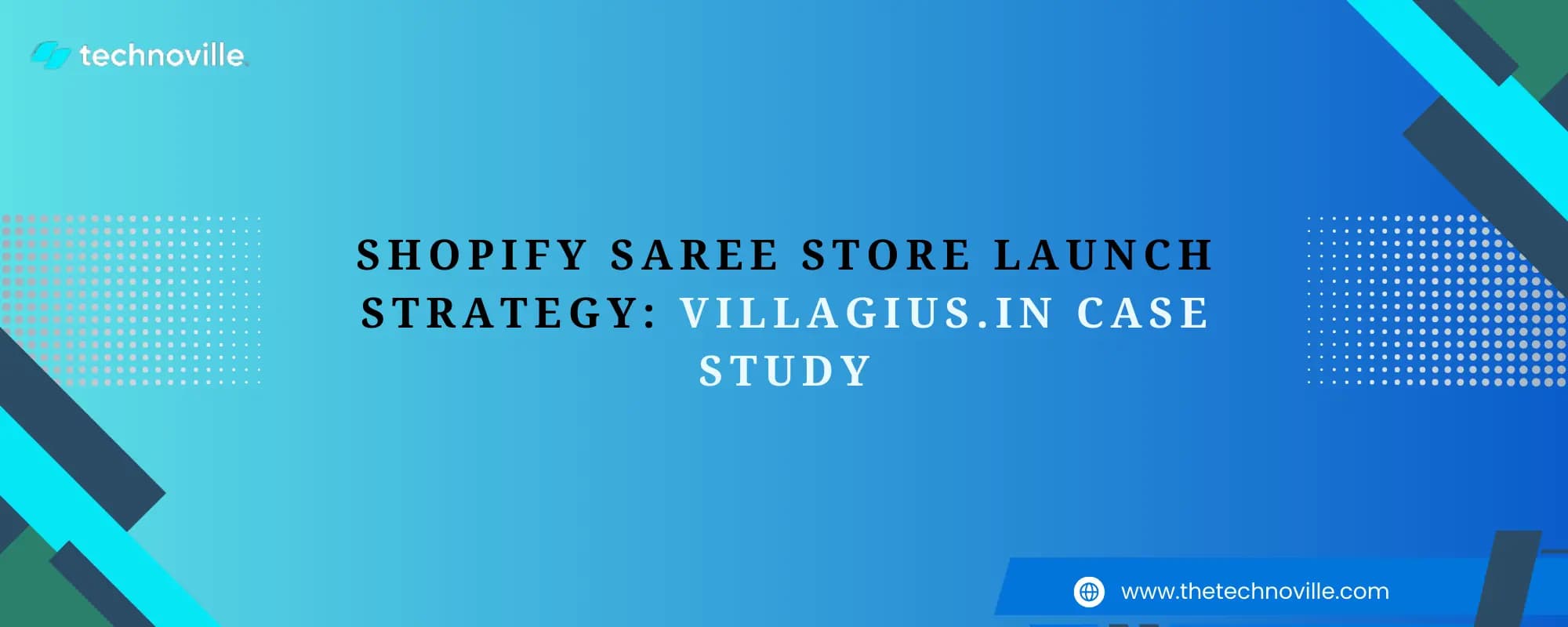Shopify Saree Store Launch Strategy: Villagius.in Case Study

In the dynamic world of performance marketing, brands are perpetually seeking innovative strategies to maximize their return on advertising spend (ROAS). Villagius, a relatively new brand in D2C space, embarked on a strategic journey over 3 months to establish its presence on Meta, Snapchat, and Google platforms. This blog explores the objectives, strategies, and outcomes of Villagius’s performance marketing campaign, providing valuable insights for marketers aiming to optimize their advertising efforts.
Objective
Villagius’s primary objective was to generate sales on its Shopify-based online store through a meticulous and phased approach. Given the brand’s newness on Meta, Snapchat and Google platforms, the strategy was to take “incremental steps” by dividing the campaign into 4 milestones aimed at achieving the desired goal. With a product range priced between ₹699 and ₹1999, Technoville understood the necessity of segmenting its audience to target them effectively.
Strategy
The campaign was structured around a funnel approach divided into 4 stages: Advantage+ Shopping Campaigns, Top of Funnel (TOF), Middle of Funnel (MOF), and Bottom of Funnel (BOF). Each stage had a distinct focus and strategy to move potential customers from awareness to conversion.
Advantage + Shopping Campaigns
Recent changes to Meta’s algorithm favoring Advantage+ shopping campaigns for performance-focused brands allowed Villagius to leverage Meta AI and machine learning algorithms. By utilizing video-based ads for top-performing products and setting a lifetime budget for the month, the overall campaign began generating stable sales with a ROAS greater than 4.2.
Top of Funnel (TOF)
The initial launch focused on maintaining a ROAS greater than 2.0 while identifying the right audience and locations for scaling. The TOF strategy involved an Add to Cart (ATC) optimized and View Content optimized campaign aimed at attracting relevant traffic to the website. This phase was critical in capturing the attention of potential customers and driving them to engage with the brand’s offerings. For a new brand, it is crucial to find the right mix of standout products through phased use of catalog, carousel and video-based creatives.
Middle of Funnel (MOF)
In the second stage, the focus shifted to engaging web visitors and social engagers with the objective of retaining and converting their interest to purchase. By leveraging a top-performing product catalog and video-based ads priced between ₹699 and ₹1999, Villagius aimed to define the Average Order Value (AOV) and maintain a strong ROAS. This approach involved creating content and offers that resonated with the audience, encouraging them to explore the brand further and consider making a purchase.
Bottom of Funnel (BOF)
The BOF stage targeted individuals who had shown a strong purchase intent, such as those who had initiated checkouts and added items to carts in the last 30 days. This segment was targeted with high-frequency ads, running a Performance Max (P-max) campaign on Google and video-based ads on Meta and Snapchat with attracting offers like Flat 25% off on entire cart value > 1999 which increased AOV by 45%. By focusing on ROAS bidding and dividing asset groups based on price range, Villagius refined its targeting to maximize conversions and achieve a higher return on investment.
Results
Over the three-month campaign period, Villagius spent ₹485,045 on Meta, generating a revenue of ₹1,507,450. This resulted in a ROAS of 3.10, indicating a successful return on investment. The campaign reached 1,970,143 people, resulting in 4,249,621 impressions and 133,885 clicks. These metrics highlight the campaign's effectiveness in not only attracting a large audience but also driving significant engagement.
Key Metrics:
Amount Spent: ₹485,045
Revenue: ₹1,507,450
Blended ROAS: 3.10
Reach: 1,970,143
Impressions: 4,249,621 Clicks: 133,885 CTR: 3.15% Number of Orders: 950
Analysis
The success of Villagius’s campaign can be attributed to its well-structured funnel approach, strategic audience segmentation, finding gem products and cutting down spends on underperforming products and locations. By starting with a broad audience in the TOF stage and gradually narrowing down to highly interested potential customers in the BOF stage, Villagius was able to optimize its ad spend and maximize conversions.
TOF Strategy:
- Objective: Attract relevant traffic.
- Tactics: ATC and View Content optimized campaigns, broad targeting.
- Outcome: High reach and impressions, setting a solid foundation for further engagement and conversions with lower acquisition cost.
MOF Strategy:
- Objective: Engage and retain web visitors and social engagers.
- Tactics: Targeted content, offers based on product range.
- Outcome: Improved AOV and sustained ROAS, moving potential customers closer to conversion
BOF Strategy:
- Objective: Convert high-intent users.
- Tactics: High-frequency ads, P-max campaigns, refined targeting, video-based ads on Meta and Snapchat.
- Outcome: Increased conversions, higher AOV and higher ROAS.
Conclusion
Villagius's performance marketing campaign serves as an exemplary case study for clothing brands looking to establish themselves on Meta, Snapchat, and Google platforms. By carefully segmenting the audience and strategically moving them through the funnel, Villagius achieved significant returns on its ad spend. The success of this campaign underscores the importance of a well-planned and executed performance marketing strategy, particularly for new brands seeking to make a mark in competitive markets.
For marketers, the key takeaway from Villagius’s approach is the importance of patience, segmentation, and continuous optimization. By setting clear objectives, understanding the target audience, and leveraging data-driven insights, brands can achieve remarkable results in their performance marketing efforts.